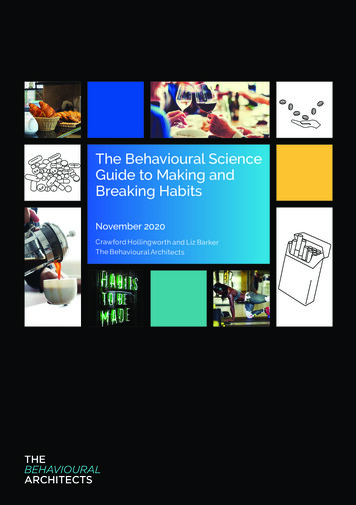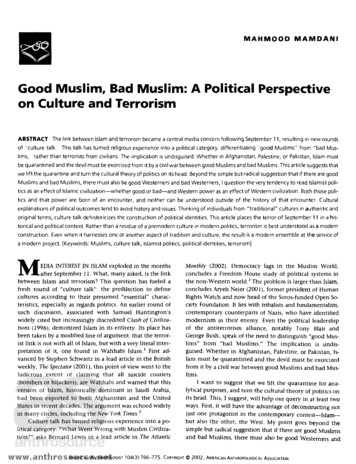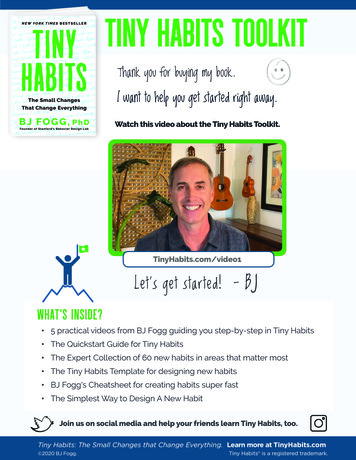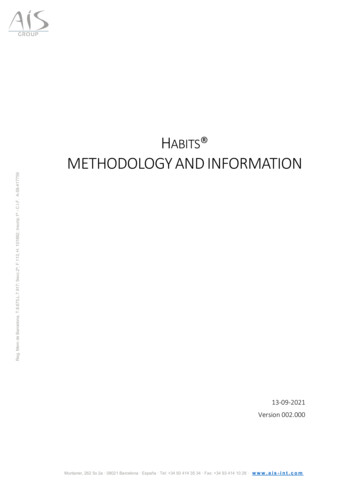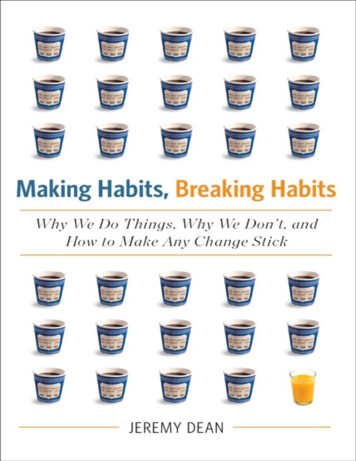
Transcription
Making Habits,Breaking Habits
Making Habits,Breaking HabitsWhy We Do Things,Why We Don’t, andHow to Make Any Change StickJEREMY DEANA Member of the Perseus Books Group
Copyright 2013 by Jeremy DeanAll rights reserved. No part of this publication may be reproduced, stored in a retrieval system, ortransmitted, in any form or by any means, electronic, mechanical, photocopying, recording, or otherwise,without the prior written permission of the publisher. For information, address Da Capo Press, 44Farnsworth Street, 3rd Floor, Boston, MA 02210.Cataloging-in-Publication data for this book is available from the Library of Congress.ISBN 978-0-7382-1608-9 (e-book)Published by Da Capo PressA Member of the Perseus Books Groupwww.dacapopress.comDa Capo Press books are available at special discounts for bulk purchases in the U.S. by corporations,institutions, and other organizations. For more information, please contact the Special Markets Departmentat the Perseus Books Group, 2300 Chestnut Street, Suite 200, Philadelphia, PA 19103, or call (800) 8104145, ext. 5000, or e-mail special.markets@perseusbooks.com.10 9 8 7 6 5 4 3 2 1
To Howard and Patricia
“For in truth habit is a violent and treacherous schoolmistress.She establishes in us, little by little, stealthily, the foothold of herauthority; but having by this mild and humble beginning settledand planted it with the help of time, she soon uncovers to us afurious and tyrannical face against which we no longer have theliberty of even raising our eyes.”—MONTAIGNE
CONTENTSPART ONEANATOMY OF A HABIT1Birth of a Habit2Habit Versus Intention: An Unfair Fight3Your Secret Autopilot4Don’t Think, Just Do It!PART TWOEVERYDAY HABITS5The Daily Grind6Stuck in a Depressing Loop7When Bad Habits Kill8Online All the TimePART THREEHABIT CHANGE9Making Habits10Breaking Habits
11Healthy Habits12Creative Habits13Happy HabitsAcknowledgmentsNotesIndex
PART 1ANATOMY OF A HABIT
1Birth of a HabitThis book started with an apparently simple question that seemed to have asimple answer: How long does it take to form a new habit? Say you want to goto the gym regularly, eat more fruit, learn a new language, make new friends,practice a musical instrument, or achieve anything that requires regularapplication of effort over time. How long should it take before it becomes a partof your routine rather than something you have to force yourself to do?I looked for an answer the same way most people do nowadays: I askedGoogle. This search suggested the answer was clear-cut. Most top results madereference to a magic figure of 21 days. These websites maintained that“research” (and the scare-quotes are fully justified) had found that if yourepeated a behavior every day for 21 days, then you would have established abrand-new habit. There wasn’t much discussion of what type of behavior it wasor the circumstances you had to repeat it in, just this figure of 21 days. Exercise,smoking, writing a diary, or turning cartwheels; you name it, 21 days is theanswer. In addition, many authors recommend that it’s crucial to maintain achain of 21 days without breaking it. But where does this number come from?Since I’m a psychologist with research training, I’m used to seeing referencesthat would support a bold statement like this. There were none.My search turned to the library. There, I discovered a variety of stories goingaround about the source of the number. Easily, my favorite concerns a plasticsurgeon, Maxwell Maltz, M.D. Dr Maltz published a book in 1960 calledPsycho-Cybernetics in which he noted that amputees took, on average, 21 daysto adjust to the loss of a limb and he argued that people take 21 days to adjust toany major life changes.1 He also wrote that he saw the same pattern in those
whose faces he had operated on. He found that it took about 21 days for theirself-esteem either to rise to meet their newly created beauty or stay at its oldlevel.The figure of 21 days has exercised an enormous power over self-help authorsever since. Bookshops are filled with titles like Millionaire Habits in 21 Days,21 Days to a Thrifty Lifestyle, 21 Days to Eating Better, and finally, the mostoptimistic of all: 21-Day Challenge: Change Almost Anything in 21 Days (atleast it acknowledges that it might be a challenge!). Occasionally, the 21-dayperiod is deemed a little too optimistic and we are given an extra week totransform ourselves. These more generous titles include The 28-Day VitalityPlan and Diet Rehab: 28 Days to Finally Stop Craving the Foods that Make YouFat.Whether 21 or 28 days, it’s clear that what we eat, how we spend money, orindeed, anything else we do, has little in common with losing a leg or havingplastic surgery. To take Dr Maltz’s observations of his patients and generalizethem to almost all human behavior is optimistic at best. It’s even more optimisticwhen you consider the variety amongst habits. Driving to work, avoiding thecracks in the pavement, thinking about sports, walking the dog, eating a salad,booking a flight to China; they could all be habits and yet they involve suchdifferent areas of our lives. But, to be fair, Maltz didn’t invent the 21-day timeframe; there are all sorts of origin stories explaining its whereabouts, most ofthem standing on science-free ground.Thanks to recent research, though, we now have some idea of how longcommon habits really take to form. In a study carried out at University CollegeLondon, 96 participants were asked to choose an everyday behavior that theywanted to turn into a habit.2 They all chose something they didn’t already do thatcould be repeated every day; many were health-related: people chose things like“eating a piece of fruit with lunch” and “running for 15 minutes after dinner.”Each of the 84 days of the study, they logged into a website and reportedwhether or not they’d carried out the behavior, as well as how automatic thebehavior had felt. As we’ll soon see, acting without thinking, or “automaticity,”is a central component of a habit.So, here’s the big question: How long did it take to form a habit? The simpleanswer is that, on average, across the participants who provided enough data, ittook 66 days until a habit was formed. And, contrary to what’s commonlybelieved, missing a day or two didn’t much affect habit formation. Thecomplicated answer is more interesting, though (otherwise, this would be a shortbook). As you might imagine, there was considerable variation in how longhabits took to form depending on what people tried to do. People who resolved
to drink a glass of water after breakfast were up to maximum automaticity afterabout 20 days, while those trying to eat a piece of fruit with lunch took at leasttwice as long to turn it into a habit. The exercise habit proved most tricky with“50 sit-ups after morning coffee,” still not a habit after 84 days for oneparticipant. “Walking for 10 minutes after breakfast,” though, was turned into ahabit after 50 days for another participant.On average, habit formation took 66 days. Drinking a glass of water reached maximum automaticity after20 days; for 50 sit-ups, it took longer than the 84 days of the study.The graph shows that this study found a curved relationship between repeatinga habit and automaticity. This means that the earlier repetitions produced thegreatest gains towards establishing a habit. As time went on these gains weresmaller. It’s like trying to run up a hill that starts out steep and gradually levelsoff. At the start you’re making great progress upwards, but the closer you get tothe peak, the smaller the gains in altitude with each step. For a minority ofparticipants, though, the new habits did not come naturally. Indeed, overall, theresearchers were surprised by how slowly habits seemed to form. Although thestudy only covered 84 days, by extrapolating the curves, it turned out that someof the habits could have taken around 254 days to form—the better part of ayear!What this research suggests is that 21 days to form a habit is probably right, aslong as all you want to do is drink a glass of water after breakfast. Anythingharder is likely to take longer to become a really strong habit, and, in the case ofsome activities, much longer. Dr Maltz and his cheerleaders weren’t even close,and all those books promising habit change in only a few weeks are grossly
optimistic. Of course, this study opens up a whole new set of questions. Theparticipants were only trying to adopt new habits; what about our existinghabits? How much better might they have done using tried and testedpsychological techniques? And this study doesn’t really tell us what a habit feelslike, how we experience it, or where it tends to happen.What do we actually do all day long? Some busy days slip by in a flash and weremember little. Whether at work or idling around at home, it would befascinating to know exactly how our time is spent and which parts are habitual.Unfortunately, there’s a very good reason why we tend to be awful at recallinghabitual behavior, which is to do with its automaticity. So psychologists usediary studies, which give a much more accurate picture of what people are up tothan we can get from memory. In one study led by habit researcher WendyWood, 70 undergraduates at Texas A&M University were given a watch alarm.3Every hour while they were awake, it reminded them to write down what theywere doing, thinking, and feeling, right at that very moment. The idea was notjust to build up a list of activities, but to see the context in which they occurred.Across two separate studies, the researchers found that somewhere between onethird and half the time, people were engaged in behaviors which were rated ashabitual. This suggests that as much as half the time we’re awake, we’reperforming a habit of one kind or another. Even this high figure may well be anunderestimate, since it’s based only on young people whose habits haven’t hadmuch of a chance to set hard.4So, what were participants in Wood’s research up to? Since they werestudents, the largest category was studying. This included attending classes,reading, and going to the library, which made up 32% of the diary entries.Amongst these activities, about one-third were classified as habitual. The nextcategory was entertainment, which participants were engaged in 14% of thetime. This included things like watching TV, using the Internet, and listening tomusic. And this time, the percentage of habitual activities went up to 54%. Nexton the list were social interactions, which made up 10% of the entries and 47%of which were classified as habitual behaviors. The category in which thebehaviors were least habitual was cleaning, down at only 21%, while thecategory which was most habitual was going to sleep and waking up at 81% (atleast they weren’t hiding their lazy, slovenly ways!).
More important than precisely what they were doing (especially for those ofus who aren’t students), are the characteristics of habits. What does it feel like?What’s going on in our minds? What emerged from this study, as it has fromothers, are three main characteristics of a habit. The first is that we’re onlyvaguely aware of performing them. Like when you drive to work and don’tnotice the traffic lights. You know some part of your mind was attending tothem, along with other road-users and the speed limit, but you often can’tspecifically remember doing so. In Wood’s study, participants reported exactlythis vagueness about their habitual behavior. While they were hanging out,watching TV, or brushing their teeth, they reported thinking about what theywere doing only 40% of the time. It’s one of the major benefits of a habit: itallows us to zone out and think about something else, like planning a trip on theweekend. Habits allow the conscious part of our minds to go a-wandering whileour unconscious gets on with those tedious repetitious behaviors. Habits helpprotect us from “decision fatigue”: the fact that the mere act of making decisionsdepletes our mental energy. Whatever can be done automatically frees up ourprocessing power for other thoughts.A habit doesn’t just fly under the radar cognitively; it also does soemotionally. And this is the second characteristic that emerged: the act ofperforming a habit is curiously emotionless. The reason is that habits, throughtheir repetition, lose their emotional flavor. Like anything in life, as we becomehabituated, our emotional response lessens. The emotion researcher Nico Frijdaclassifies this as one of the laws of emotion and it applies to both pleasure andpain.5 Activities we once considered painful, like getting up early to go to work,become less so with repetition. On the other hand, activities which excite or giveus pleasure initially, like sex, beer, or listening to Beethoven’s 7th, soon becomemundane. Of course, we fight against the leaking away of pleasure, sometimeswith success, by seeking variety. This is why some people feel they have to keeppushing the boundaries of experience just to get the same high.None of this means we don’t feel emotion while performing a habit, it’s justthat the feelings we experience usually have less to do with the habit and more todo with where our minds have wandered off. Wood’s research found this exactpattern in participants’ reports of their emotional experience. Compared withnon-habitual behaviors, when people were performing habits their emotionstended not to change. In addition, the emotions that people did experience wereless likely to be related to what they were doing than when their activities werenon-habitual. The fact that habitual behavior doesn’t stir up strong emotions isone of its advantages. Participants in this study felt more in control and lessstressed while performing habits than they did enacting non-habitual behaviors.
The moment that participants switched to non-habitual behaviors, their stresslevel increased.The third important characteristic of a habit is so obvious that we often don’tnotice it. Perhaps this is partly a result of the automatic nature of habits. Takesome typical daily routines: You get up in the morning, go to the bathroom, andtake a shower . . . Later you’re in the car when you turn on your favorite radiostation . . . Then, at the coffee shop, you order a blueberry muffin . . . Theconnection is context. We tend to do the same things in the same circumstances.Indeed, it’s partly this correspondence between the situation and behavior thatcauses habits to form in the first place.The idea that we create associations between our environment and certainbehaviors was memorably demonstrated by the Russian physiologist, IvanPavlov. In Pavlov’s most famous research, carried out on dogs, he created anassociation between being fed and a ringing bell. Then, after a while, he triedringing the bell without feeding the dog. He noticed that the dog began tosalivate anyway. The bathroom, car, and coffee shop are like Pavlov’s bell,unconsciously reminding us of long-standing patterns of behavior, which wethen enact again, in exactly the same way as before. This is backed up byresearch on humans that shows that people tend to perform the same actions inthe same contexts. In the diary study described above, most of the behaviors, likesocializing, washing, and reading were carried out in the same place.It becomes clear just how much context is important for habit whenever youmove house or get a new job. Once in a new home, it’s suddenly difficult to dothe simplest of jobs. Making a sandwich becomes an ordeal as you have toconsciously think about where the knives and plates are. It’s not just simple tasksthat become more difficult; it’s all your usual routines. From getting up in themorning to going to bed at night, so many tasks feel like they’re being done forthe first time. You may even find yourself trying to carry out your old habits inyour new home, to no avail: because everything has moved, suddenly thoseingrained ways of behaving fail you. The same goes for new jobs. Where onceyou glided around the workplace on autopilot from one task to the next, in thenew job you feel like a fish out of water.Psychologists have seen how important context is in research on how peoplecope with changes to their environment. In one study, students’ habits weretracked as they transferred to a new university.6 They were asked how often theywatched TV, read the paper, and exercised both before the move and afterwards.They were also asked about the context in which these habitual behaviors wereperformed. How did they perceive the context, where were they physically, andwho was with them at the time? The answers to these questions built a picture of
whether the context had really changed with the move from one location toanother. For example, it’s possible that although a physical location changes, theoverall context doesn’t. Like hotel rooms, one dorm room can look much likeanother; so it might not feel that things have changed much.What the participants reported as they moved from one university to anotherwas that context was important in habit change. They found that if they wantedto cut down their TV and increase their exercise, it was easier to do so after themove. This is because new surroundings don’t have all the familiar cues to ourold habits. Without these cues, our autopilot doesn’t run so smoothly and ourconscious mind keeps asking us what to do. That’s why moving house is likegoing on holiday: without your established routines, you have to keepconsciously thinking about what you’re going to do now. The same thinghappened to these students. Instead of automatically watching TV or reading thenewspaper, they were more likely to think, “What did I plan to do today?” and“What do I actually want to do now?” As a consequence, a world of possibilityopens up.The rather bland word “context” can also include other people. Whether wenotice it or not, we are heavily influenced by those around us. The researchers inthis study found that participants’ behavior was disrupted by any changes in thebehavior of those around them. For example, students reported they changedtheir newspaper reading habits if those around them changed theirs. It isn’tnecessarily the case that we copy other people, just that they tend to cause somechange in us. This ties in with the finding that people who live alone report moreof their daily behaviors as being habitual than those who live with others.7 Otherpeople, then, disrupt our routines, sometimes for better, sometimes for worse.Now we’ve seen how habits are born, what they feel like, and how much ofour daily lives they take up. Three characteristics have emerged: firstly, weperform habits automatically without much conscious deliberation. Secondly,habitual behaviors provoke little emotional response by themselves. Thirdly,habits are strongly rooted in the situations in which they occur. We also knowthat they can vary considerably in how long they take to form. But how muchcontrol do we have over our habits? If we want to make a change, how easy willit be?
2Habit Versus Intention: An Unfair FightWe like to think that our habits follow our intentions. If I want to form a habit,I should be able to. Say I decide to switch from white to whole-wheat bread. Ibuy it from the store a few weeks in a row; I like it so I keep getting it. Witheach repetition, the habit gets a little stronger, and after a few months I’mpicking it up off the shelf without even thinking. I intended to eat more healthily,and now I am. Just the same sort of process, with our intentions flowing into ourhabits, goes on in all sorts of areas of life: learning to ride a bike, dance, or cook.Individual physical actions are built up over time into chains of behavior weperform automatically.Mental habits can be built up in just the same way, again with intentionsflowing into habitual ways of thinking. You might decide you’re being too harshon a friend, say, by always thinking they are selfish. You make a mental note tospot a more benevolent trend in their behavior. You notice when they buy you adrink and listen to your problems. Small things, but steps in the right direction.Sure enough, you start to think of them as less selfish. Unconsciously, thehabitual ways in which you think about your friend have changed.Our mental habits can change in this way because our minds are so good atspotting patterns; indeed, it’s one of the mind’s chief functions. Our ability tospot patterns at low levels and build them up into a habit, based on our consciousintentions, enables us to reach much more complex goals. Here’s an examplefrom a classic psychology study. Participants sat in front of a computer foralmost an hour, pressing one of four buttons corresponding to where a crossappeared on the screen.1 Naturally, it was very boring, but the experimenters hada little trick up their sleeve. Unknown to the participants, there was a pattern in
where the crosses appeared. Despite it being consciously undetectable, theparticipants began to respond faster as the study went on—they were learningthe pattern. When interviewed afterwards, though, none had noticed anything:they had learnt it without realizing. This is a study about unconscious learning,but it demonstrates how mental habits can grow out of patterns. Here, anunconscious learning process was in the service of a higher level intention: to dowell on the test and please the experimenters.When you learn to shoot a basketball through a hoop or reverse a car into atight space, it’s the physical equivalent of this unconscious mental learningprocess. Lots of small unconscious actions are built up to achieve one bigconscious goal: shooting a hoop or parking a car. In the mental realm,mathematics is an early example of this building-up process. At school, we learna series of operations we can perform on numbers to reach a goal: say, workingout the average height of our classmates. Although learning these basicoperations (addition and division) can be excruciating for young minds, theysoon become second nature. Later on, we can perform them almost withoutconscious thought, which enables us to complete much more complexcalculations. Once again, the habit of particular mental or physical operationshelps us achieve a whole series of higher-order goals.We all have an intuitive sense that our habits are built up purely in the serviceof our goals (remember that bad habits are also goal-oriented, although the goalmay not be a good one, like getting drunk to forget one’s problems). Indeed, thestronger people’s habits, the more they believe that those habits are goaloriented.2Our intuitive sense that intentions lead straight into habits is far from just a layunderstanding. Many influential psychologists have expressed exactly the sameidea. Generations of first-year undergraduate psychologists are taught thatintentions are a major key to predicting behavior. They learn theories withgrand-sounding names like the “model of interpersonal behavior,”3 the “theoryof planned behavior,”4 and the “theory of reasoned action,”5 which all suggestthat when we form an intention, it leads us to act in line with that intention.These are influential ideas across different sub-disciplines of psychology andthey underpin much research.Now these theories are being challenged because, like our intuitiveunderstanding, they don’t tell the full story. We may like to think our intentionsflow directly into our habits, but often they don’t. It’s an idea we resist becauseit strikes at our sense of having free will. We like to think that things happen fora reason, and one of those reasons is because we decided it would happen, or at
the very least, that someone else decided it would happen. Yet habits don’t flowsolely from our intentions and there are studies that demonstrate this.Worse for our sense of agency, it’s possible for intention and habit to becompletely reversed. Sometimes we unconsciously infer our intentions from ourhabits. How the habit started in the first place could be a complete accident, butwe can then work out our intentions from our behavior, as long as there’s nostrong reason for that behavior. Say I take a walk around the park everyafternoon and each time I follow a particular route which takes me past a duckpond. When asked why I take this route, I might reply that I like to watch peoplefeeding the ducks. In reality, I just walked that way the first time, completely atrandom, and saw no reason not to do the same the next day. Now, after the habitis established, I try to come up with a reason and the ducks spring to mind. I endup inferring intention from what was essentially just chance.We know people regularly do this sort of backwards thinking, and reallybelieve it. One of the most famous examples in psychological research iscognitive dissonance. This is the idea that people don’t like to hold twoinconsistent ideas to be true at the same time. Studies conducted more than half acentury ago find that when people are induced into behavior that is inconsistentwith their beliefs, they simply change their beliefs to match.6 It’s like whensomeone ends up spending too much on a new car. Instead of feeling bad aboutthe clash between their original plan and what they’ve actually done, they preferto convince themselves that the car is worth the extra money. This is a result ofour natural desire to maintain consistency between our thoughts and actions. Weall want to be right, and one thing we should all be able to be right about isourselves. Backwards thinking allows us to do just that.But surely we would know if we were doing this kind of backwards thinking?Unfortunately, though, we have little access to these sorts of unconsciousprocesses. It turns out that in experiment after experiment, psychologists canchange minds without participants realizing. In one study on attitudes, peopleclearly changed their mind on an issue after being bombarded with reasons to doso.7 Despite this, they claimed the arguments had had no effect on them; indeed,they thought their new attitudes were what they had always thought. It seemspoliticians aren’t alone in blanking out their U-turns. Like it or not, we’re allcapable of it.
What we’ve explored so far are two extremes: when we create habitsintentionally for a particular purpose and when we infer intentions from ourbehavior. In real life, though, both of these processes happen at the same timeand habit is a combination of our intentions and our past behavior. So here’s thecrucial question: What kind of combination? Can the intention to start eatinghealthily or get a new job really overcome the habit of eating junk food andgoing to the same office every day?We already know quite a lot about this question because psychologists arevery keen to change people’s behavior, hopefully for the better. Studies ondonating blood, exercising, recycling, and voting have all examined whether it’spossible to change people’s habits. One of these tested if participants couldpredict their own consumption of fast food, how much they watched TV news,and how often they rode the bus over a week.8 Each person was asked how muchthey intended to carry out each of those three behaviors over the coming week.Then, they were asked how often they had performed each behavior in the past.These are the measures of intention and habit. Over the next 7 days, participantsnoted down how often they went into a fast-food restaurant, watched TV news,and rode the bus.The results showed that when established habits were weak, intentions tendedto predict behavior. So, if you don’t watch TV news that much, your intentionfor the coming week, whether it’s to watch more, less, or the same, is likely to beaccurate. Good news for our sense of self-control. Here comes the bad news. Ashabits get stronger, our intentions predict our behavior less and less. So, whenyou’re in the habit of visiting fast-food restaurants, for example, it doesn’t mattermuch whether you intend to cut it down or not, chances are that your habit willcontinue.It gets worse, though. Participants were also asked how confident they were inpredicting their behavior over the coming 7 days. An unusual result emerged.Those with the strongest habits, who were the least successful in predicting theirbehavior over the coming week, were the most confident in their predictions.The finding is striking because it hints at one of the dark sides of habits. Whenwe perform an action repeatedly, its familiarity seems to bleed back into ourjudgments about that behavior. We end up feeling we have more control overprecisely the behaviors that, in reality, we have the least control over. It’sanother example of our thought processes working in the opposite way to ourintuitive expectations.
Considering how powerful habits are in the face of conscious intentions, it isvital to know what a strong habit is compared with a weak habit. For example, isbuying a pair of shoes once a month a habit? What about reading the newspaperevery day or attending a community meeting twice a year? How often before wefind it increasingly difficult to stop ourselves or, put the other way around, nolonger have to force ourselves? Psychologists have looked at this in a review of60 different research reports on habitual behavior.9 They classified habits intotwo categories. In the first they put things like exercising, coffee drinking, andusing a seat belt; the kinds of things that you might do at least once a week. Inthe second category they put the kinds of things we might only do a few times ayear. They included things like donating blood or getting flu shots, but could justas easily include going to the dentist or getting a haircut. The other importantthing they took into account was the context in which each repeated action tookplace. Context is a vital component of habitual behavior because we tend toperform the same actions in
participants, though, the new habits did not come naturally. Indeed, overall, the researchers were surprised by how slowly habits seemed to form. Although the study only covered 84 days, by extrapolating the curves, it turned out that some of the habits could have taken around 254 days to form—the better part of a year!
